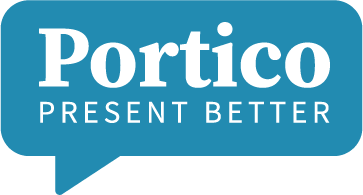If you’re wondering how to maximize your productivity at the office, reconsidering the meeting is a good place to start.
CEOs spend more of their working hours – approximately 30% – in meetings than doing anything else. (source: London School of Economics and Harvard Business School). This data point doesn’t begin to reflect how much time the rest of the organization spends preparing for them. We’re not too happy about all of the time we’re spending in meetings. Articles from the Wall Street Journal and Harvard Business Review range from instructive pointers to near-rants on meeting behaviors.
Because nearly every discussion about presentations turns to meetings, a by-product of our work is creating strategies to help you also “meet better.” Consider the following three guidelines if you’d like to benefit by having fewer, yet more productive, meetings:
First, create an agenda in the form of a question.
Questions prompt thought. They invite us to share ideas or offer an opinion, and this lets attendees know that they’re expected to participate. When attendees all participate in focused way – around specific questions – meetings tend to be more productive and rewarding.That said, you might not immediately reach a final decision on the question(s) you pose (the agenda can also be a set of questions); many leaders prefer to reflect and make decisions afterwards. The important point is that you’ve created the context for an exchange of perspectives, which leads to a more informed decision-making process.
Relatedly, if you’re convening a meeting solely for informational purposes, you have alternatives that are more effective, such as a thoughtfully written intranet post with links to more detail via another tool (e.g., Slack, Yammer), email or memo (remember them?). In other words, if you can move forward without feedback on the information you’re sharing, a meeting isn’t your best communication tool. (If you’re providing training, that’s different. We’ll cover that in a separate post).
When we frame our agendas as questions, we’re removing the concept of using them to share “updates.” Provide your updates elsewhere. For example, share the status of a project if you’ve reached a point that needs a course correction – e.g., if your project is running behind schedule, ask colleagues for help fixing a specific problem. If everything is running smoothly, congratulations! Save that information for performance evaluations.
Second, invite fewer people.
That said, what’s the optimal number? Most research points to 6 or 7 people if you want everyone to participate. Getting our colleagues to collaborate, after all, is how we extract value from having hired so many smart people. A strategically limited invite list takes on greater importance if you need to get closer to a decision or narrow options. On the other hand, if you’re brainstorming, you can benefit from more participants, especially if they are from outside of your team and bring a new perspective.
Note: If you have a colleague who actively dislikes meetings or has a consistently packed calendar, do everyone a favor and give them a meeting sabbatical. Keep them informed, but give the meeting-fatigued person the space to gain control over their commitments. When they’re ready to return, in all likelihood they’ll find that the culture of meetings has changed for the better.
Finally, set expectations on behaviors.
Now that you’ve framed the meeting agenda as a question (or questions) and limited the number of participants, you’ve provided signals to those attending that they should prepare to contribute. Consider other ways that you can limit distractions and ensure that you can get the most out of the brainpower you’ve assembled. Here are a few ideas to get you started:
Invite attendees to leave their laptops, tablets and smartphones at the door. We’ve seen enough research to know that multi-tasking is a myth. Electronic distractions also deprive attendees of the benefit of observing colleagues’ facial expressions, body language and other non-verbal cues (in fact, it’s the absence of this opportunity that makes conference calls so difficult).
Bottom line: notepads are ok, electronics less so. If it is critical to document the discussion or conduct research in real-time, assign one person to take this responsibility. Consider alternating this task so that it’s not always falling to the office worker bee. Following the meeting, sit down with the note taker to compare their findings with yours. More often than not people come away with different understandings of what transpired. Having this exchange gives you important feedback on how well your messages came across and whether there’s consensus on meeting outcomes.
Provide guidelines on interruptions. In brainstorming sessions, they’re almost inevitable. They’re healthy. In tense situations, they’re less productive. Set the expectation at the beginning of the meeting so that no one feels singled out.
Then, if necessary, have a frank discussion with whoever consistently exhibits distracting behavior. This behavior could take the form of of dominating the meeting, qualifying each statement before getting to the point or question, or making passive aggressive remarks. Phrase your discussion in a way that you point out distracting behaviors without making it feel like a personal attack.
When people feel free to constantly interrupt or make derisive comments, we’re letting them send a message that colleagues shouldn’t speak up. We confirm an individual’s fear that there’s too much risk if they articulate an opposing viewpoint or introduce data that challenges assumptions. Creating a culture where there’s a healthy exchange is important because diverse teams deliver better results. (Source: Sallie Krawcheck, McKinsey, Kellogg)
The Takeaway. It’s incumbent upon us to demonstrate greater respect for our colleagues’ time by spending more of our own considering what it is we want out of the meeting.
Too often we convene meetings because we’re uncertain about what we should do next or lack the political skills to build consensus. Or we worry (with reason) that our colleagues don’t read what we send them, so we might not invest time using other communication channels.
Take a moment to reflect on whether you’re calling a meeting because you need collaboration or if you’re solving workplace insecurity.
If we’re having fewer meetings even though we still need to share the same amount of information, we’re forced to adjust how we use other communication tools. This might mean devoting more time writing better emails, memos and reports. That’s actually a good use of our time. Writing well isn’t about showing command of the language; it’s demonstrating that we understand our topic and our audience. Our colleagues will be more likely to read and remember our work. Hopefully they will return the favor in their own writing.
A remarkable thing happens in organizations as one person significantly improves the quality of their content. It tends to set expectations as to how others should communicate.
Go ahead and take the first step. Set the communication bar a bit higher.
And let me know what happens!



